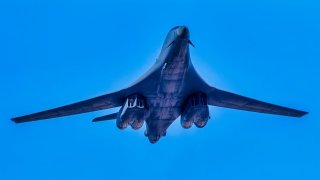Swarms of Missiles: How China Plans To Win a War Against America
China aims to challenge U.S. military dominance in the Indo-Pacific by 2049 through modernizing its forces, expanding its navy, and excelling in the fourth industrial revolution. Central to its strategy is the cost-effective "anti-access/area denial" (A2/AD) approach, focusing on missiles rather than matching U.S. capabilities ship-for-ship.
Summary: China aims to challenge U.S. military dominance in the Indo-Pacific by 2049 through modernizing its forces, expanding its navy, and excelling in the fourth industrial revolution. Central to its strategy is the cost-effective "anti-access/area denial" (A2/AD) approach, focusing on missiles rather than matching U.S. capabilities ship-for-ship. This strategy includes neutralizing U.S. forward-deployed forces and bases, such as Guam, with long-range and hypersonic missiles, targeting aircraft carriers, and disabling critical military infrastructure through cyberattacks and electromagnetic disruption. China's comprehensive plan underlines the need for the U.S. to reassess its military posture in the region.'
The Missile Might: China's Strategy to Counter U.S. Forces in the Indo-Pacific
China has committed itself to challenging the US military in its near-abroad. First, by modernizing their forces over the last decade. Second, by expanding the size and scope of their navy. Third, by enhancing their rocket forces. All the meanwhile, China has become a key player in the global race to dominate what most experts refer to as the “fourth industrial revolution,” thereby strategically benefiting from all the advancements made in industries, like quantum computing, biotechnology, hypersonic weaponry, and many others.
At its core, though, China has married its grand ambitions of displacing the United States as the dominant power, at least in the Indo-Pacific, by the hundredth-year anniversary of the founding of the People’s Republic of China—2049—with an affordable and practical defense strategy (unlike the decadent war planners in Washington).
Missles: China Plans to Beat America Cheaply
Specifically, China has made a commitment to rebuffing the threat that forward deployed US military forces pose to them. This has come in the form of what’s known as “anti-access/area denial” (A2/AD). Rather than do as the Soviet Union once did in the Cold War, Beijing is not trying to match their American rivals ship-for-ship or plane-for-plane. They are seeking cost-effective weapons that can keep US forces over-the-horizon, buying Chinese forces the time and space they need to conduct offensive operations against their neighbors, such as Taiwan.
For all the talk recently about China’s growing aircraft carrier fleet, these systems are not the crux of their military capabilities in the Indo-Pacific. Far from it. They are ancillary to China’s overarching strategic goal of denying the Americans access to the region closest to China’s maritime borders. And because the geography of the Indo-Pacific is defined by its vast ocean, making US forces operate far from the United States, with few landmasses from where to project power, US capabilities here are severely limited (hence why Washington has over-emphasized the importance of aircraft carriers).
China’s Missile Power
These missiles would overwhelm whatever defensive systems that the US airbases in the region have. Targeting the runways and fuel depots of the US bases in the region, the Chinese missile forces could ensure that the American warplanes assigned to the Indo-Pacific could not takeoff. Even if some US planes did manage to get airborne before the runways were destroyed, these planes would basically be left without a place to land.
China Won’t Stop at US Bases
Meanwhile, any Chinese attack on US bases in the region would not be an isolated affair. Beijing’s planners understand that their forces would need to comprehensively attack—and defeat—US military assets in the region. Aircraft carriers would be a key target. Airborne refuelers would be tracked and shot down as well. On top of all that, Chinese forces would target critical US military satellites in orbit, knocking them out, rendering US forces deaf, dumb, and blind.
A sustained Chinese cyberattack upon US military targets and, possibly American civilian infrastructure, would wreak havoc on the American side. Taiwan itself would be thrown into chaos as sustained Chinese attacks cascaded across the embattled island. For the American forces that would engage the Chinese in a fight, Beijing’s forces would disrupt the electromagnetic (EM) spectrum upon which so many important American systems rely to function properly, further degrading the US military.
But knocking those bases out would be a main variable in any Chinese attack against Taiwan. Under present conditions, the Chinese would likely be successful in significantly degrading the American position in the Indo-Pacific before even the US forces could retaliate against China. Washington must seriously reassess its position in the region and the disposition of its forces before China thinks it can beat the United States in a surprise attack.
About the Author
Brandon J. Weichert is a former Congressional staffer and geopolitical analyst who is a contributor at The Washington Times, as well as at American Greatness and the Asia Times. He is the author of Winning Space: How America Remains a Superpower (Republic Book Publishers), Biohacked: China’s Race to Control Life, and The Shadow War: Iran’s Quest for Supremacy. Weichert can be followed via Twitter @WeTheBrandon.


